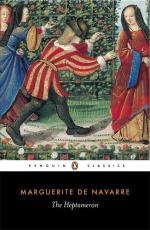FIRST DAY.
Tale I. The pitiful history of a Proctor of Alencon, named St. Aignan, and of his wife, who caused her husband to assassinate her lover, the son of the Lieutenant-General
II. The fate of the wife of a muleteer of Amboise, who suffered herself to be killed by her servant rather than sacrifice her chastity
III. The revenge taken by the Queen of Naples, wife to King Alfonso, for her husband’s infidelity with a gentleman’s wife
IV. The ill success of a Flemish gentleman who was unable to obtain, either by persuasion or force, the love of a great Princess
V. How a boatwoman of Coulon, near Nyort, contrived to escape from the vicious designs of two Grey Friars
Tale vi. How the wife of an old valet of the Duke of Alencon’s succeeded in saving her lover from her husband, who was blind of one eye
VII. The craft of a Parisian merchant, who saved the reputation of the daughter by offering violence to the mother
Appendix to the First Day
ENGRAVINGS
To face page Queen Margaret of Navarre. Frontispiece.
Prologue: The Story-tellers in the Meadow near
The Gave. By S.
Freudenberg
FIRST DAY.
Tale I. Du Mesnil learns his Mistress’s Infidelity
from her Maid. By S.
Freudenberg
II. The Muleteer’s Servant attacking his Mistress. By S. Freudenberg
III. The King Joking upon the Stag’s Head
being A fitting Decoration. By
S. Freudenberg
IV. The Princess’s Lady of Honour hurrying
to her Mistress’s Assistance.
By S. Freudenberg
V. The Boatwoman of Coulon outwitting the Friars. By S. Freudenberg
VI. The Wife’s Ruse to secure the Escape of her Lover. By S. Freudenberg
VII. The Merchant transferring his Caresses from
the Daughter to the
Mother. By S. Freudenberg
PREFACE.
The first printed version of the famous Tales of Margaret of Navarre, issued in Paris in the year 1558, under the title of “Histoires des Amans Fortunez,” was extremely faulty and imperfect. It comprised but sixty-seven of the seventy-two tales written by the royal author, and the editor, Pierre Boaistuau, not merely changed the order of those narratives which he did print, but suppressed numerous passages in them, besides modifying much of Margaret’s phraseology. A somewhat similar course was adopted by Claude Gruget, who, a year later, produced what claimed to be a complete version of the stories, to which he gave the general title of the Heptameron, a name they have ever since retained. Although he reinstated the majority of the tales in their proper sequence, he still suppressed several of them, and inserted others in their place,




